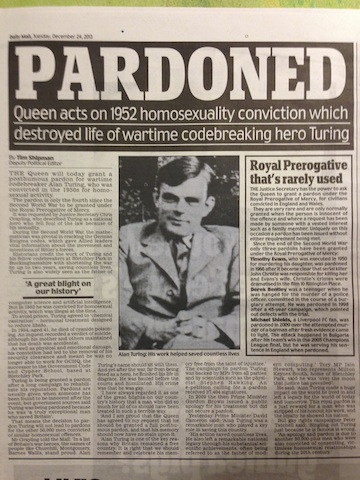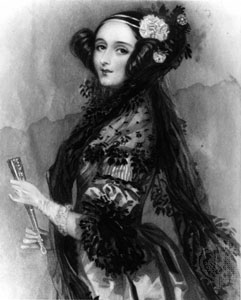
What the academics don’t tell you about Alan Turing and about Colossus
The name Alan Turing has been much in the public consciousness of late with the film ‘Breaking the Code’ and ‘Alan Turing: The Enigma’: the book that was to Inspire the Film ‘The Imitation Game’. We read in en.wiki that: “The Princeton Alumni Weekly named Turing the second most significant alumnus in the history of Princeton University, second only to President James Madison.
Wiki: A 1.5-ton, life-size statue of Turing was unveiled on 19 June 2007 at Bletchley Park…
…Turing was prosecuted in 1952 for homosexual acts, when such behaviour was still criminalised in the UK. He accepted treatment with oestrogen injections (chemical castration) as an alternative to prison. Turing died in 1954, 16 days before his 42nd birthday, from cyanide poisoning. An inquest determined his death a suicide, but it has since been noted that the known evidence is equally consistent with accidental poisoning.”
http://en.wikipedia.org/wiki/Alan_Turing

Wiki tries to justify the brutality of the misguided medical treatment:
With ‘Alternative death theories ‘:
“Philosophy professor Jack Copeland has questioned various aspects of the coroner’s historical verdict, suggesting the alternative explanation of the accidental inhalation of cyanide fumes from an apparatus for gold electroplating spoons, using potassium cyanide to dissolve the gold, which Turing had set up in his tiny spare room. Copeland notes that the autopsy findings were more consistent with inhalation than with ingestion of the poison. (I suppose he would know, him being a Philosophy professor?) Turing also habitually ate an apple before bed, and it was not unusual for it to be discarded half-eaten. In addition, Turing had reportedly borne his legal setbacks and hormone treatment (which had been discontinued a year previously) “with good humour” and had shown no sign of despondency prior to his death, setting down, in fact, a list of tasks he intended to complete upon return to his office after the holiday weekend. At the time, Turing’s mother believed that the ingestion was accidental, resulting from her son’s careless storage of laboratory chemicals. Biographer Andrew Hodges suggests that Turing may have arranged the cyanide experiment deliberately, to give his mother some plausible deniability. ”
http://en.wikipedia.org/wiki/Alan_Turing#Alternative_death_theories
“Law professor John Stinneford has argued that chemical castration is a cruel and unusual punishment because it exerts control over the mind of sex offenders to render them incapable of sexual desire and subjects them to the physical changes caused by the female hormones used.” https://en.wikipedia.org/wiki/Chemical_castration#Effects
Wiki: Turing’s biographers Andrew Hodges and David Leavitt have suggested that Turing was re-enacting a scene from the 1937 Walt Disney film Snow White, his favourite fairy tale, both noting that (in Leavitt’s words) he took “an especially keen pleasure in the scene where the Wicked Queen immerses her apple in the poisonous brew”.” http://en.wikipedia.org/wiki/Alan_Turing#Alternative_death_theories
Under the watchful eye of their master skeptics, Wiki editors would have called the above a “conspiracy theory”, but this is academic Alan Turing and a “coroner’s historical verdict”. This is the New Inquisition who make-up the rules as they go along. “In the end, it comes down to proof. We’re not curmudgeons”, said skeptic master Susan Gerbic. “We just want more facts when someone makes a claim.”
http://www.montereyherald.com/general-news/20141231/skeptics-gather-in-seaside-for-first-local-skepticamp
From theguardian.com we read that: “The family of the codebreaker Alan Turing will visit Downing Street on Monday to demand the government pardons 49,000 other men persecuted like him for their homosexuality.”
http://www.theguardian.com/science
/2015/feb/22/family-alan-turing-government-petition-pardons-gross-indecency-homosexuality
Well yes, that may be a good idea!
The author cannot but wonder if Turing’s elevation to science super-stardom has more than a little to do with his treatment at the hands of those who chemically castrated him – I am speaking of course of the scientific community who were advisors and willing accomplices to such crimes of gender prejudice.
Then we have another headline at theguardian.com:
“Misgivings over the pardon of Alan Turing” “Most of us appreciate the pardon of Alan Turing, but we cannot atone for his appalling treatment and eventual suicide by persisting in the “Colossus misconception”. Professor Jack Copeland and Paul Gannon, in their books on Colossus, draw attention to the misconception that Turing played some part in the design and build of the world’s first electronic computer. Turing was in America when Tiltman and Tutte broke the more complex Fish/Tunny code.
Thomas H Flowers, a Post Office engineer, already using valves, knew he was the only one with the expertise to build an electronic machine that would speed up the urgent deciphering process. His offer to build a machine was turned down. He went back to Dollis Hill and, with his own money, built Colossus. Installed in January 1944, it was an immediate success and allowed the Allies to read messages between Hitler and his high command. It was Colossus that shortened the war by two years and saved millions of lives. It was Flowers who led the world into the electronic computer era we now live in. When asked what part Turing played in the Colossus computer, Flowers said “he had nothing to do with it”. Why the misconception persists and Flower’s role is diminished is worthy of some consideration. He may himself have been the victim of a different form of discrimination. His degree in electrical engineering was gained at night school at London University. He was not an Oxbridge chap and was referred to at Bletchley Park as “the cockney”.”
http://www.theguardian.com/science/2013/dec/25/misgivings-pardon-alan-turing
As we see above, not everyone is happy with the pseudo-official version and an alternate more historically accurate version is freely available to those who take the trouble to do a little research. But skeptics take heart. I’m quite sure that you, medieval monks and educationally biased individuals will still cling to the myth of Turing whilst ignoring the historical man.
That the bright spark of genius is more apt to visit the keen amateur than the educated professor is a universal law that seems to be wholly unacceptable to academic science. And so they build their own phantom, a caricature of grim academic genius, a fantasy visited on an unsuspecting soul, alive or dead. They manufacture in preconceived image and groom him like a Hollywood movie star. They overload him with unearned acclaim. We will see in these pages that Turing is not alone in being posthumously groomed for scientific super-stardom.
Scientific American “How Alan Turing Invented the Computer Age”
scientificamerican.com “Turing demonstrated (read theorised) you could construct a single Universal Machine that could simulate any Turing Machine. One machine solving any problem, performing any task for which a program could be written – sound familiar? He’d invented the computer.” http://blogs.scientificamerican.com/guest-blog/2012/04/26/how-alan-turing-invented-the-computer-age/
Although Wiki says: “A Turing machine is not intended as practical computing technology, but rather as a hypothetical device representing a(n infinite) computing machine.” http://en.wikipedia.org/wiki/Turing_machine

Where did he get his ideas?
“Supposing, for instance, that the fundamental relations of pitched sounds in the science of harmony and of musical composition were susceptible of such expression and adaptations, the engine might compose elaborate and scientific pieces of music of any degree of complexity or extent.”
Ada Lovelace
Augusta Ada King-Noel, Countess of Lovelace (née Byron; (1815 – 1852) was an English mathematician and writer, chiefly known for her work on Charles Babbage’s proposed mechanical general-purpose computer, the Analytical Engine. Wiki
We might even invent laws for series or formula in an arbitrary manner, and set the engine to work upon them, and thus deduce numerical results which we might not otherwise have thought of obtaining; but this would hardly perhaps in any instance be productive of any great practical utility, or calculated to rank higher than as a philosophical amusement.
Ada Lovelace

He (Turing) wrote in COMPUTING MACHINERY AND INTELLIGENCE – “I propose to consider the question, “Can machines think?”” http://loebner.net/Prizef/TuringArticle.html
And even after all these years the answer is still a resounding “NO”, computers are adding machines, not thinkers. The computer is only as good as the programmer – who is hopefully, able to think. Artificial Intelligence is a Sci-Fi dream although there are clever programs that appear to imitate intelligence. It’s done by trickery and is only believed by those who are blinded by Hollywood and the hype of the scientific press.
Sometime during the early 1990’s the author saw an article about a psychologist who thought that the questions he asked his patients could easily be computerised; and he was right. Based on the article, I wrote a Basic program called ‘Sympathy’. It involved the computer asking the same question three times in different ways and certain parts of the answers were used to provide answers to the questioner’s problem. I was surprised at the time spent by my wife and daughter talking to a program that was using their answers to solve their own problems… and this was all done with 64K of memory. This is how easy it is to emulate the ‘Turing Test’ and I take no credit for being a genius, it was a very simple program.
 Turing said, “Can machines think? a machine could be said to be “intelligent” if it could fool a human questioner into thinking that it was a human being.” This is what I did and this is the famous Turing test. It has been used in an unending and pointless scientific debate about what it means to be intelligent – or not. Science has always embraced this brand of surrealism whilst at the same time condemning it in other areas of endeavour. Science has no clue about what constitutes intelligence or even what thinking is all about and this can be easily explained by the materialist paradigm that says the brain is a computer à la Turing.
Turing said, “Can machines think? a machine could be said to be “intelligent” if it could fool a human questioner into thinking that it was a human being.” This is what I did and this is the famous Turing test. It has been used in an unending and pointless scientific debate about what it means to be intelligent – or not. Science has always embraced this brand of surrealism whilst at the same time condemning it in other areas of endeavour. Science has no clue about what constitutes intelligence or even what thinking is all about and this can be easily explained by the materialist paradigm that says the brain is a computer à la Turing.
Alan Turing did not crack the code, nor did he play any part in the design or building of Colossus and it’s doubtful that his theories made any contribution to subsequent computer development other than encouraging fantasies regarding AI. He did very little, but I’ve read much about what academics say he did, accompanied by not a jot or iota of evidence that he did any such things. Turing is the scientific myth that the actual man – Alan Turing would have rejected in the light of modern computing.
How influential was Alan Turing?
The tangled invention of computing (and its historiography) Shreeharsh Kelkar March 24, 2015
“…Theory, Haigh argues, was not necessary to build the first digital computers, although that theory proved very useful to building the discipline called “computer science.” Ideas followed practices, and not the other way around. (Turing, to be fair, was involved in building and programming actual computers, however it’s his theoretical ideas that seem to be most valued by Copeland and others.)
Our urge to believe the computer projects of the late 1940s were driven by a desire to implement universal Turing machines is part of a broader predisposition to see theoretical computer science driving computing as a whole. If Turing invented computer science, which is itself something of an oversimplification, then surely he must have invented the computer. The computer is, in this view, just a working through of the fundamental theoretical ideas represented by a universal Turing machine in that it is universal and stores data and instructions interchangeably.” http://blog.castac.org/2015/03/how-influential-was-turing/
Go to Computers 1B: Turing secrets and lies
